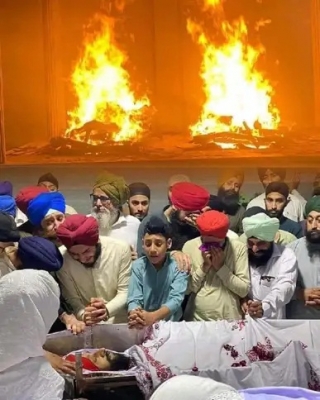By Anwesha GhoshNew Delhi, May 19: The brutal killing of two Sikh traders by unidentified gunmen in Pakistan’s northwest Khyber Pakhtunkhwa (KPK) province, bordering Afghanistan on May 15, has brought back the focus on the predicament of the Sikhs minority community members in the Af-Pak region.
This was the second targeted killing of a member of Sikh community in Pakistan in the last eight months – in September 2021, ISIS-K claimed responsibility for the killing a Sikh Unani medical practitioner in Peshawar.
Since 2016, some prominent Sikh community members were murdered in KPK including Pakistan Tehreek-e-Insaaf National Assembly member Soren Singh.These targeted killings of Pakistani Sikhs over the past few years, raised fear that Sikhs of Pakistan might end up experiencing the tragic fate like that of their Afghan counterpart.
The ebb and flow of people and ideas between Indian subcontinent and what constitutes modern day Afghanistan and Pakistan predates the emergence of modern nation-state.Founder of Sikhism, Guru Nanak lived and died in Gurdwara Darbar Sahib in present day Kartarpur Pakistan in the 16th Century.
He made two trips to Afghanistan in 1521 and 1540 and propagated the faith.
Under the leadership of Ranjit Singh, the Sikhs expanded their influence by seizing Multan, Kashmir, and later extending their control westward, capturing Peshawar in 1834.
Their rule came to an end after the British annexed Panjab to British-India.
Increased trade between Afghanistan and British-India compelled traders and merchants to travel across the region.
Sikhs who settled in the North-West Frontier Province (now called KPK) and Sindh in Pakistan, travelled along a network of trade routes stretching from Lahore to Peshawar and to Nangarhar, Kabul, and Kandahar.These traders and merchants were from two communities: the Sindhi Shikarpuris and the Panjabi Khatris, while the former returned to their home base, the latter settled in the KPK and areas beyond the Durand Line.
The partition of the Indian subcontinent in 1947 and the bloody sectarian conflict between Hindus and Muslims that followed forced many Sikhs and Hindus to flee to India, but many in KPK province decided to stay back having cultivated good relations with their Pashtun neighbours.
Afghan Sikh community, which once numbered in the tens of thousands, has been ruined and devastated by years of emigration and death, driven by conflict, systemic discrimination, targeted killing and the rise of religious extremism in post-Soviet Afghanistan.
Bulk of the Afghan Sikhs fled Afghanistan during the civil war in 1990s, yet some remained.Many also returned after the fall of the Taliban in 2001 to take part in the nation building activities.
However, as the security situation deteriorated, majority found it difficult to live in Afghanistan.
If the Jalalabad attack in 2018 (that killed nearly the entire Afghan Sikh leadership) shook the members of these communities; the massacre of the Sikh Gurudwara by the Taliban in March 2020 convinced majority of remaining Afghan Sikhs to leave.
Before the Taliban takeover of Kabul in August 2021, 99 per cent of Sikhs and Hindus had left and the remaining were left with a choice between “converting to Islam or run away”.The image of the last Afghan Sikhs carrying their Holy scripture Guru Granth Sahib, boarding the Indian Air Force plane at the Kabul Airport – as part of an evacuation efforts by Indian government – will continue to haunt the members of these communities.
Hindus and Christians constitute the largest and second largest religious minority groups respectively in Afghanistan’s neighbour Pakistan.The Ahmadis, Sikhs and Parsis are considered among the notable religious minorities.
Since Pakistani authorities excluded the Sikhs from the last census in 2017, reliable data on the community is difficult to locate.
According to reports, Sikh population in Pakistan has dramatically come down within the past two decades- from around 40,000 in 2002 to 8, 000 presently, settled mostly in KPK, followed by Sindh and Punjab.
Along with education, poverty and discrimination, the pressure of conversion to Islam are some of the challenges faces by the community.In absence of a strong pro-minority legislation in Pakistan there is hardly any legal protection from forced conversions.
The news of alleged abduction and conversion of a Narkhana sahib Sikh girl led to public outcry in 2020.
While the opening of Kartarpur Sahib corridor (that links the Dera Baba Nana shrine in northwest India’s Gurdaspur with the Gurdwara Darbar Sahib in Pakistan) was hailed as a noble move by Pakistan but the reports of forced conversions and targeted killings of the dwindling Sikh population in Pakistan have alarmed the Sikh community within and outside Pakistan.
Religious minorities remain soft target of non-state actors and religious extremists in Pakistan.In 2007, the Pakistani Taliban imposed Jizya (Tax levied on non-Muslims living in Muslim state) and brutalized 11 Sikh families in Orakzai district of KPK for not payment of the same.
Although, Pakistani authorities on various occasions have promised to safeguard the rights and interests of the minority communities, however repeated attacks narrate the abject failure on their part to provide safety and security to the minority communities.If this continues, the predicament of the Sikhs of Pakistan might not be very different from that of the Sikhs of Afghanistan.
(Anwesha Ghosh is a strategic analyst and author based in New Delhi)
(The content is being carried under an arrangement with indianarrative.com)
–indianarrative
#Peshawar #Pakistan #Afghanistans #Sikhs #Delhi # Nani #Nani #Delhi #New Delhi #Gurdaspur #Lahore
.






